c. 1951-1952—Monterey, California
The Zappa family moved away from Edgewood, Maryland, in November 1950.
I want to dispel an erroneous statement that our family moved to California in 1950. I was born in 1951, so I am 11 years younger than Frank and we moved to California that same year. [...] We lived in Monterey, Pacific Grove, Montclair and Claremont, San Diego and I went to high school in Pomona.
My father was working in civil service and he was moved all over the country, and, by a process of elimination we wound up in Southern California. We almost wound up in Dugway, Utah at one point because he had been offered a job at this place where they were developing nerve gas during World War II. He came home one day, with photographs of this area, and asked how we would like to move there. No way! It was hideous! So we got off lucky on that one.
My Dad had gotten another offer to work at the Dugway Proving Ground in Utah (where they made nerve gas), but we got off lucky—he didn't take it. Instead, he took a position at the Naval Post-Graduate School in Monterey, teaching metallurgy. I had no idea what the fuck that meant.
So, in the dead of winter, we set out in our 'Henry-J' (an extinct and severely uncomfortable, small, cheap car manufactured then by Kaiser), via the Southern Route, to California. The backseat of a 'Henry-J' was a piece of plywood, covered with about an inch of kapok and some stiff, tweedy upholstery material. I spent two exhilarating weeks on this Ironing Board From Hell.
The Zappa clan made its way to California in December, 1951. We came west in a Henry J my Dad purchased for the trip to California. [...] We ended up in Monterey—all expenses paid by the U.S. Navy.
The first house Mom and Dad rented in Monterey [...] was an old two-story Victorian with a wrap-around porch and a big kitchen.
c. 1952—Summer School
I went to a summer school once when I was in Monterey, and they had, like, basic training for kids who were going to be in the drum and bugle corps back in school. I remember the teacher's name was Keith [McKillop], and he was the rudimental drummer of the area in Pacific Grove. And they had all these little kids about 11 or 12 years old lined up in this room. You didn't have drums, you had these boards—not pads, but a plank laid across some chairs—and everybody stood in front of this plank and went rattlety-tat on it.
I started off with orchestral percussion, learning all the rudiments—things called flams, ruffs, ratamacues and paradiddles. I had taken a summer-school group course in Monterey with a teacher named Keith McKillop. Instead of drums, he had us practicing on wooden planks. We had to stand in front of the planks and practice the rudiments used in Scottish drumming.
FZ, interviewed by Ralph Denyer, Sound International, April/May, 1979
When I was 12? I didn't listen to any music, I just wanted to play drums. My parents couldn't afford a record player. There was nothing good on the radio, I just wanted to play the drums, I liked the way they sounded.
c. 1952-53—Pacific Grove
After living in Monterey for only eight months we moved to Pacific Grove. We left the big Victorian house we had come to love and the Portuguese families we were finally developing a connection with. We ended up in a smaller rental not far from the center of Pacific Grove.
At one time [my father] was teaching at the Naval Post-Graduate School at Monterey, California, and we were so poor then that on weekends [...] we would drive toward Salinas and try to find a lettuce truck and wait for something to fall off it.
Pacific Grove isn't far from a place called Castroville, which, according to the Chamber of Commerce, is the "Artichoke Capital of the World."
[...] On Saturday mornings in the summer, Dad packed Frank and me into the car. The three of us headed to the artichoke farms in Castroville. [...] Dad waited for the trucks headed to town to stop and deliver the crops for shipment.
[...] We waited for the trucks to turn off of the dirt roads when they cme from the fields and drove toward the highway. Artichokes bounced out when the truck tires made the jump from dirt to asphalt.
Dad turned Frank and me loose to grab the free artichokes. [...] Artichokes, iceberg lettuce, and broccoli were what he considered prize catches.
Social And Club Activities, Monterey Peninsula Herald, October 10, 1952
St. Angela CDA Adds Members at Monday Meeting
Court St. Angela, Catholic Daughters of America, added 18 members Monday night in impressive initiation ceremonies at the Pacific Grove Woman's Civic Club.
[...]
The court's new members include Betty Jo Bettencourt, Mary Carney, Wanda Flores, Ellen Heady, Theola Leighton, Lorraine Loustaunau, Pat Mathewson, Helen Morin, Mary Catherine McHale, Edna Niell, Eleanor Noel, Patricia Quigley, katherine Rokop, Frances Selbicky, Helen Tobin, Roberta Watson, Rosemarie Zappa and Stella Zonski.
Puppets
We moved from Monterey to Pacific Grove, a quiet town nearby. I spent my recreational hours building puppets and model planes and making homemade explosives from whatever ingredients I could find.
During this period, Frank spent time concentrating on creative efforts. He finally got Dad to get him a model plane kit and was meticulous at putting it together.
He also constructed landscapes out of cardboard and made puppets out of paper mache, felt, wire, and pieces of cloth. This was the same time he developed a curiosity about explosives.
Driven to rely in his own resources, he built model planes, conducted puppet shows using figures he had made and clothed himself, and pursued an ongoing fascination with explosives that led to several potentially harmful accidents
My brother-in-law, Jett Spencer, told me recently that he and Frank would actually present the puppet shows at the Grove Theater and they were filmed . . . to be shown during the Sat. matinees later.
In the early 1950s, I'm not certain of the exact year but I suspect it was 1953, Frank was a student at Robert H. Down school on Pine St. In Pacific Grove, CA. He along with myself and another friend had a puppet show called "Madcap Puppets." The third friend's father built the stage. Even then Frank was a superb promoter. He got us booked on to a children's show on live TV in Salinas, arranged to have us perform on stage during Saturday afternoon intermissions at the Pacific Grove Theater, and as a stage act at the Monterey County Fair in Monterey. The only part of the act I recall clearly was a takeoff by Stan [Freberg] of the popular TV crime series, "Dragnet," which [Freberg] re-titled "St. George and the Dragonet." So far as I know, this was Frank's first real show business success.
Stan Freberg's St. George & The Dragonet was released in 1953, so that fits.
The third person was Jett Spencer, although at the time he used his middle name, Monroe, as his given name. Incidentally, as I remember it, we performed our shows live at the Grove Theater. The manager had an early 8mm camera and he did film us but I don't recall his showing the films publicly. I don't remember the name of the tv kid's show on which we appeared, but the station was KSBW Ch 8, Salinas, CA. It has the same call letters today. I can't say for certain how long Frank lived in P.G. but my hazy recollection is that it was about a year. As for photos or film of our show, I don't know of any. About a year ago I happened across an email address for Frank's widow and I wrote to ask whether Frank had ever mentioned the P.G. shows. In a gracious response, she said that he had when she asked him about a small costume she had found tucked away. He said it was from the Dragonet bit. Finally, this was my only experience with puppets.
According to wikipedia, KSBW started broadcasting on September 11, 1953.
At least during the Pacific Grove period we used hand puppets.
Charles Ulrich, December 12, 2013
Today I talked with Jett Monroe Spencer, who did puppet shows with FZ in Pacific Grove. He confirmed some of the details previously provided by Bill Dorman on affz. They were known as Madcap Puppets. Spencer's father built the puppet stage. They performed at the local movie theatre, the county fair, and on the Salinas television station.
He said that their shows for the movie theatre were filmed in advance (as his brother-in-law Chet Zebroski reported second-hand on affz), whereas Bill Dorman remembered performing live.
He remembered two Stan Freberg records they did puppet shows to: St. George & The Dragonet (mentioned by Dorman) and Banana Boat Song. Later, FZ wrote original scripts for the puppet shows.
He mentioned making explosives out of ping pong balls.
Special thanks to Javier Marcote for the Monterey Herald Peninsula article.
c. 1954—Oak Park Drive, Claremont, CA
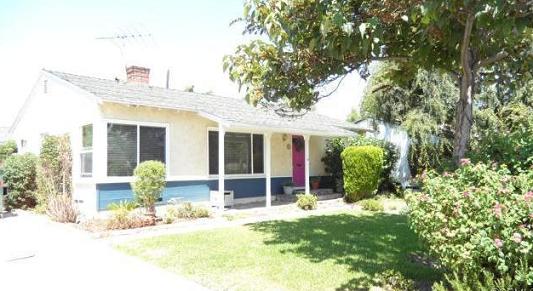
A real estate listing for 257 Oak Park Drive in Claremont bills the house as "the Childhood Home of Legendary Musician Frank Zappa!"
The house for sale was the one we moved to first in 1952, I was a baby, and Frank was about 11. It was the house next to it that we lived in around 1958-1959.
Bobby Zappa, July 17, 2006
We moved to Claremont, not Pomona, in 1953. That was the first time we lived there.
In 1954, after living in Monterey and Pacific Grove for three years, Dad moved us to Southern California. I was 10 and Frank was 13 and neither of us was happy about leaving Northern California. [...] Dad did get a better job. It was with Convair, a defense contractor in Pomona, California.
"Claremont's nice," said Zappa. "It's green. It's got little old ladies running round in electric karts."
c. 1954—Claremont High School, Claremont, CA
During the '50s, I went to four separate high schools. Although each was in Southern California, their images were distinctly different. I went, in chronological order, to Claremont High School in Claremont, Grossmont High School in El Cajon near San Diego, Mission Bay High School in San Diego, and Antelope Valley High School in Lancaster, where I graduated.
[Frank] attended the junior high section of Claremont High School. He also used to visit a music store in Claremont called the Folk Music Center on Harvard Avenue.
[...] After we settled in Claremont, Frank and I became more comfortable in our new hometown and we were able to make friends. For Frank, his interest in music became his connection.
He joined the orchestra in junior high playing drums. He participated in band performances and he got to know other students with similar interests in music.
1955—Mortensen Meets Zappa
Vic Mortensen: I went to Claremont High, and that's when I (first) met Frank Zappa, when I was in the marching band in seventh or eighth grade, I don't know which. We had to go out and play (at) a football game, and in those days, the (drum) skins were literally skins. You would get out and it would start to "mist up" a little bit, and you'd keep tightening your heads, otherwise, you'd play the national anthem and it would sound like a funeral dirge, because everybody's playing a tom-tom. OK, then you get back on the bus and you kept loosening up and loosening up and loosening up. I've heard drums explode. So, I had gone up to the band room, to make sure that the drumheads were still loose enough. There was this crazy guy in there who had taken all of the band drums and lined them all up and had tuned them down to tom toms. He was going "bump bump a diggy bump bump a diggy bump bump." I said, "What the . . . are you doing?" He said, "Wow, man, I don't have a drumset and I just wanted to try out some different sounds." I asked, "How'd you get in here?" and he said, "Well, I know the guy" (probably referring to the janitor). I was fascinated. He was doing some pretty good things. Didn't see him again until I was a freshman in high school. Never forgot him—that's how we got together years later. [...] He was about a year older than I was. He couldn't have been much older. I had never seen him around the school. I said there were five hundred kids and there was "a dude in the band room that I had never seen at school."
Many from the Claremont High Class of 1958 remember him. "Yep, he was there," said Karl Hertz, who sat three rows ahead of Zappa in Eleanor Galloway's English class. "We all knew Frank," concurred Jerry Peairs. "He may not have stayed a year or ended a year, but he was there." [...]
In a conversation at a Claremont record shop about the then-famous Zappa, the clerk, Doug Galloway, said his mother had taught Zappa. The English teacher remembered him, Galloway told [Murray] Gilkeson, because his vocabulary was so large, she had to look up some of the words he used in essays.
[...] Gilkeson has found about 20 students who remember Zappa from eighth and ninth grade. At the breakfast, Hertz, Peairs and Stu Holmes said Zappa drummed in the marching band, produced a wall-sized mural of outer space for a science project and cut up in English class. Gilkeson has collected more anecdotes, of Zappa reciting a poem in front of one class and participating in a skit in another, absorbing information without taking notes, ad-libbing a science talk in a German accent. "Everybody knew Frank. He was just a little off-center," Diann Irvine told Gilkeson.
Case in point: Classmates John Peek and Nelson Scherer told Gilkeson that they and Zappa did a puppet act on a talent show on KHJ, placing second. Puppetry is an unusual hobby for a teenager, I remarked at the breakfast. "Some of us were car guys, and Frank was into puppets and music," Peairs observed.
One student could place Zappa firmly in the ninth grade. Steve Thorne told Gilkeson that his family moved to Claremont in 1954, when he started ninth grade, and that he ate lunch with Zappa, who was in his class. [...] A photo from an eighth grade talent show, which appears in Claremont's El Espiritu yearbook of 1954, is said by classmate Barbara Norton to depict Zappa, whom she knew well—although, frustratingly, the boy in the photo isn't named.
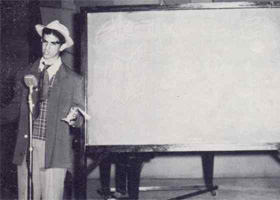
Charles Ulrich, December 4, 2013
I finally talked with Nelson Scherer, who did puppet shows with FZ in Claremont.
The most important information he provided is that Claremont High School was a six-year school (grades 7-12) at that time and they were in eighth grade when they did puppets.
Puppets
The Ewings lived a few doors down the street and Zappa made puppets with their son, which they entered in the LA County Fair. They soon fell out and Zappa became a solo puppet master.
July 18, 1955—Disneyland
On July 18, [1955,] Disneyland Amusement Park opened to the public. [...] We went to Disneyland that first day it opened. Frank had been anxious to see the park, because he knew there would be lots of shapely teenage girls running around.
R&B
I didn't really get into contact with anything that resembled musical expression until I was about 14 or 15 years old, which is when I got to hear some of it on the radio. I remember riding around in a car and by accident while somebody was turning the station, we came across some oddball station out in Chino, California that was playing a record called "I" by the Velvets.
[...] They were playing "I" by the Velvets and I said, "What was that?" And my father says, "No, turn it away! Don't listen to that!" And then that gave me the first inkling that there was something interesting about to happen in the world, then about a week later I heard, I went looking for that same radio station where the weird music was coming out of, and I mashed to hear another record called "Riot In Cell Block Number 9," by The Robins, then proceeded to go to a place that actually sold records, I'd never been to a record store before, I thought that was a good place to start and went in there, and in those days you could take a record into the little room and listen to it before you bought it, so I snatched up "Work With Me Annie" and two or three other . . . A Joe Houston record, and I listened to it and I was hooked!
FZ, interviewed by Ralph Denyer, Sound International, April/May, 1979
One day we were driving around in the car and a famous record came on the radio. It was called "I" by The Velvets on the Red Robin label. I thought: Boy, that sounds really great. My parents were saying: Turn that screaming nigger music off the radio! That wasn't even a screaming nigger record, it was just a nice ballad. I thought maybe there was more of the same music where that came from. I started checkin' round and sure enough there was. Shortly thereafter I managed to convince them life was impossible without a record player and that is when the trouble began.
[...] When we got the first record player they gave my mother a record with it called "The Little Shoemaker" by some white harmony group, I can't remember who. It was a really stupid record and she used to listen to that while she was ironing, she wasn't that into it. My father used to play guitar when he was in college with some little troubadour type band, playing all kinds of old songs. But he hadn't touched it in years, it would just sit in the closet.
Around the time of his thirteenth birthday, Frank was riding in the Henry J with his parents when "Gee" by the Crows came on the radio, followed by the Velvet singing "I." "It sounded fabulous," said Zappa. "My parents insisted it be dismissed from the radio, and I knew I was on to something . . . "
Special thanks to Murray Gilkeson.
1954-1955—El Cajon, California
After a year of living in Claremont we packed up and moved farther south to El Cajon, a town east of San Diego. [...] Frank started the ninth grade at Grossmont High in El Cajon.
In 1954, we moved to San Diego.
Grossmont High School
At Grossmont High School, the only things the kids had to be proud of were the size of their student body and the fact that their marching band was really spiffy. Grossmont didn't have just middle and upper middle-class whites, but those it did dressed Buckle Back, though not as severely as Claremont. They wanted to go to San Diego State 'cause they thought it was swinging, or Tempe, in Arizona, 'cause they had heard it was a party school. Their image was superficially clean. They didn't come to class drunk out of their minds; they saved boozing for the weekend.
March, 1955—Blackboard Jungle
In my days of flaming youth I was extremely suspect of any rock music played by white people. The sincerity and emotional intensity of their performances, when they sang about boy friends and girl friends and breaking up, etc., was nowhere when I compared it to my high school Negro R&B heroes like Johnny Otis, Howlin' Wolf and Willie Mae Thornton.
But then I remember going to see Blackboard Jungle. When the titles flashed up there on the screen Bill Haley and his Comets started blurching "One Two Three O'Clock, Four O'Clock Rock . . ." It was the loudest rock sound kids had ever heard at that time. I remember being inspired with awe. In cruddy little teen-age rooms across America, kids had been huddling around old radios and cheap record players listening to the "dirty music" of their life style. ("Go in your room if you wanna listen to that crap . . . and turn the volume all the way down.") But in the theater, watching Blackboard Jungle, they couldn't tell you to turn it down. I didn't care if Bill Haley was white or sincere . . . he was playing the Teen-Age National Anthem and it was so LOUD I was jumping up and down. Blackboard Jungle, not even considering the story line (which had the old people winning in the end) represented a strange sort of "endorsement" of the teen-age cause: "They have made a movie about us, therefore, we exist . . ."
April 13, 1955—"No Picnic"
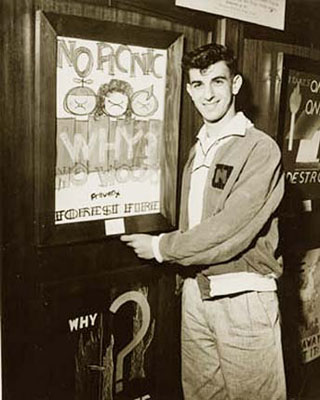
Foothill Echoes, Grossmont, California, May 10, 1955
Frank Zappa, 9th grade, submitted the winning poster to the annual poster contest held by the California Division of Forestry, April 13. "There were 399 entries from 30 schools," said James G. Fenlon, State Forest Ranger.
R&B & Varèse
I think the very first record I got was a 78 of "Riot in Cell Block Number Nine."
FZ, interviewed by Kurt Loder, Rolling Stone, 1988
The first music that I heard that I liked was Arab music. But I can't imagine where I heard it, because my parents didn't even have a record player until I was fifteen. Then, finally, they got a record player, and I think the first rhythm & blues record that I got was "Riot in Cell Block #9" by the Robins. And shortly thereafter, I read an article about Edgard Varese in Look magazine, and I found the Varese album, and so that's what I had. I had the Robins and Varese, and I think I got "Work with Me, Annie," by Hank Ballard and the Midnighters, too.
[...] I saw it as a totally unified field theory. What appealed to me in the Varese album was that the writing was so direct. It was like here's a guy who's writing dissonant music and he's not fucking around. And here's a group called the Robins, and they didn't seem like they were fucking around, either. They were havin' a good time. Certainly Hank Ballard and the Midnighters sounded like they were having a good time. And although harmonically, rhythmically and in many other superficial ways it was very different, the basic soul of the music seemed to me to be coming from the same universal source. You know: a guy who had the nerve to stand up and say, "This is my song, like it or lump it."
Back then, my record collection consisted of five or six rhythm-and-blues 78-RPM singles. [...]
One day I happened across an article about Sam Goody's record store in Look magazine [...]. The article went on to say something like: "This album is nothing but drums—it's dissonant and terrible; the worst music in the world." Ahh! Yes! That's for me!
I wondered where I could get my hands on a record like that, because I was living in El Cajon, California—a little cowboy kind of town near San Diego.
There was another town just over the hill called La Mesa—a bit more upscale (they had a 'hi-fi store'). Some time later, I was staying overnight with Dave Franken, a friend who lived in La Mesa, and we wound up going to the hi-fi place—they were having a sale on R&B singles.
Puppets
The first thing I ever did in "show business" was to convince my little brother Carl to pretend he was my ventriloquist dummy, sit on my lap and lip-sync "Riot In Cell Block Number 9" by the Robins at the Los Angeles County Fair.
[...] I used to build models (not from kits, because I couldn't follow the simple instructions). I used to build and sew clothes for puppets and marionettes. I used to give puppet shows using Stan Freberg records in the background.
That's how I got started in, let's say, show business. Some of the first things that I did involved puppets, and I've always liked puppets.
George Latshaw, Puppetry Journal, winter 1984
[FZ] said he had done puppets of all sorts back in the 50s, even painting lines on his brother's face to turn him into a vent figure. Zappa used his index fingers to trace the pattern from the corners of his mouth down below the jaw line to indicate the marks of a dummy's moveable mouth. It was logical to use puppets for his concert, because he couldn't get the kind of imagery he wanted by using people.
[Time For Beany] was that rarest, most elusive of creatures: A kids' show that adults enjoyed watching—and not just any adults. Among its declared fans were Groucho Marx, Albert Einstein and the kid who would grow up to be Frank Zappa. (Allegedly, Einstein once cut short a high-level meeting on quantum molecular mechanics by announcing, "Excuse me, gentlemen, but it's Time For Beany!")
[...] Time For Beany was damned clever. Actually, there were many clever folks involved in its production but its producer-creator and its two performers were three of the cleverest humans ever in show business. They were, respectively, Bob Clampett, Stan Freberg and Daws Butler.
And the thing that I like about Albert Einstein and I hope it's not an apocryphal story—He liked the television show that I liked, which was Time For Beany. I heard a story that he left an important meeting one time telling the people he had to go watch Time For Beany. And I hope that's true.
1955-1956—Clairemont, California
Bobby Zappa, July 22, 2006
We lived in Claremont, California twice. We also lived in a town called CLAIREMONT (different from the other one) after we lived in El Cajon before we moved to Lancaster. We lived in that Clairemont for about a year after El Cajon, so that would be from 1955 to 1956—then in 1956 we moved to Lancaster and in 1959 back to Claremont, the town near Pomona.
After a year in El Cajon we moved again. This time we didn't move far, just a little farther northwest to a small town called Clairemont—not to be confused with Claremont near Pomona.
Electronic Music
Synapse: When did you first become aware of the synthesizer?
Zappa: I've known about the synthesizer since I read about Oscar Sala's Mixtur Trautonium, and it's been over 20 years. It was reported in this article that it makes sounds like chordal glissandos of kettle drums and things like that, and I said, hey, that's for me, but of course in those days there were no synthesizer records, and anybody who was dealing with electronic music had to be in "New York."
Synapse: Were you aware of other people doing things in Europe, like Stockhausen, and people
Zappa: This was before Stockhausen.
Synapse: But in the early 50's, after the war, when they started doing tape pieces?
Zappa: Yeah, Pierre Henry and yeah, I knew about that stuff. In fact there was a record store in Clairmont California that occasionally got some of these unusual, very rare recordings, and since it was so primitive in those days, you could actually go into a record store and listen to the record before you bought it. I actually went in there and listened to that music. I had a chance to really hear it. Of course I couldn't afford to buy it, but I heard it. I have since acquired a lot of those records, though. I have a pretty good collection of electronic music.
1955-1956—Mission Bay High School, San Diego
Mission Bay was different. First, it was a very transient neighborhood; a lot of the kids' fathers worked in the navy. It was definitely juvenile delinquent territory. You wore a leather jacket and very, very greasy hair. You carried a knife and chain. If you were really bad, you mounted razor blades in the edge of your shoes for kicking. Also, you made sure you carved up the school's linoleum floor by wearing taps on your soles. If you failed to do any of these things you would (1) not get any sex action, and (2) probably be injured.
Frank was now in tenth grade attending Mission Bay High School on Grand Avenue in San Diego. Mission Bay High was a tough place. It was filled with pachukos, Mexican gangs who fought with white kids and the other pachuko gangs.
[...] I wasn't concerned about grades and never felt competitive with other students because so many of our moves occurred in the middle of a school year.
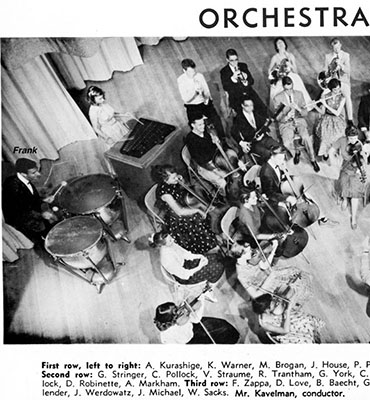
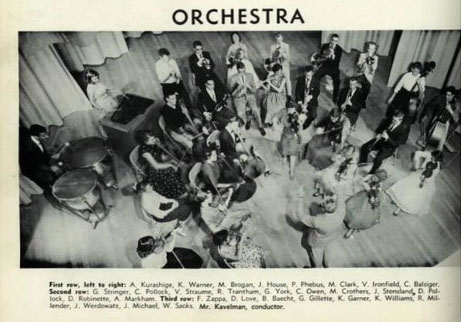
ORCHESTRA
First row, left to right: A. Kurashige, K. Warner, M. Brogan, J. House, P. Phebus, M. Clark, V. Ironfield, C. Balsiger. Second row: G. Stringer, C. Pollock, V. Straume, R. Trantham, G. York, C. Owen, M. Crothers, J. Sternland, D. Pollock, D. Robinette, A. Markham. Third row: F. Zappa, D. Love, B. Baecht, G. Gillette, K. Garner, K. Williams [Kenny Williams?], R. Millender, J. Werdowatz, J. Michael, W. Sacks. Mr. Kavelman, conductor. [p. 73]
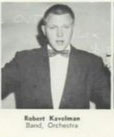
Robert Kavelman
Band, Orchestra
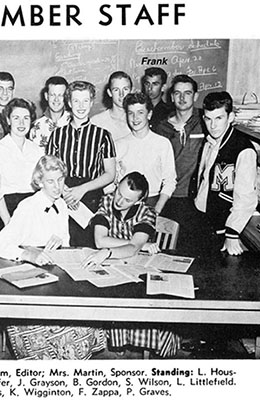
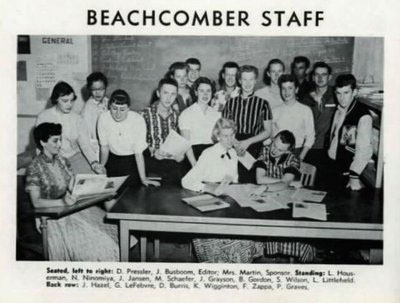
BEACHCOMBER STAFF
Seated, left to right: D. Pressler, J. Busboom, Editor; Mrs. Martin, Sponsor. Standing: L. Houserman, N. Ninomiya, J. Jansen, M. Schaefer, J. Grayson, B. Gordon, S. Wilson, L. Littlefield. Back row: J. Hazel, G. LeFebvre, D. Butris, K. Wigginton, F. Zappa, P. Graves. [p. 89]
Although there is no record of future Rock 'n Roll Hall of Famer Frank Zappa participating in interscholastic athletics during his Mission Bay years, apparently he did exhibit an interest in an early Middle Eastern form of baseball, perhaps an off-shoot of seker-hemat. According to The Beachcomber (December 16, 1955), several students were asked how they planned to spend the upcoming New Year's Eve. Zappa replied, "Gonna get stoned."
This is the earliest year for which Frank Zappa appears in a high school yearbook, from the 1955-56 school year. Based on a variety of sources, he was in his very first musical group called the Ramblers and the pianist from the Ramblers (Stewart Congden [Congdon]) is shown in this book as a Junior.
There were a few teachers in school who really helped me out. Mr. Kavelman, the band instructor at Mission Bay High, gave me the answer to one of the burning musical questions of my youth. I came to him one day with a copy of "Angel in My Life"—my favorite R&B tune at the time. I couldn't understand why I loved that record so much, but I figured that, since he was a music teacher, maybe he knew.
"Listen to this," I said, "and tell me why I like it so much."
"Parallel fourths," he concluded.
He was the first person to tell me about twelve-tone music. It's not that he was a fan of it, but he did mention the fact that it existed, and I am grateful to him for that. I never would have heard Webern if it hadn't been for him.
I listened to the [Edgard Varèse] record and I liked it and I asked my music teacher in high school whether or not there were other composers who were writing material like this, and he gave me some other names.
One such little old lady had doing some work at her house for a couple weeks now. Her husband (Robert, a man in his 80's) is confined to a wheelchair and she (Elizabeth) is in her 70's but recovering from hip replacement surgery. [...] "Oh, Robert was Frank Zappa's band director when he taught at Mission Bay High School in California!" she says. She then produces a clipping from the Kalamazoo Gazette, Saturday, January 27, 2007 edition wherein Dave Person goes out and interviews Robert Kavelman about being mentioned in Zappa's autobiography. Apparently Zappa credits Robert with exposing him to twelve-tone music. I thought this was about the coolest thing i'd heard in a long time. I went inside and engaged Robert in conversation. He said when the interview started he didn't really know anything about Frank Zappa but as he went through his old school pictures and such was like, "Oh yeah! I remember that kid!" Robert's a real great old guy. . naturally curious about things still. He even showed me that he went out and got two books on Zappa to read up on his former student. One was the Zappa autobiography, and another was Zappa: A Biography by Barry Miles. Robert Kavelman is mentioned in both books!
When I was going to school in San Diego, at a place called Mission Bay High School, there was really popular local band functioning at that time called The Blue Notes which featured a guy called Wilbur Whitfield. And we were all very proud of Wilbur when he escaped from San Diego and went to Los Angeles to record ["P.B. Baby"] on the Aladdin label.
[Gary LeFebvre] attended Mission Bay High School, where he played in the marching band with fellow San Diegan Frank Zappa.
"Frank and I would sit down at the piano and trade 'weird chords'," LeFebvre recalled in a 2006 U-T San Diego interview. "My original goal was to be able to play music with anybody and not drag anybody down. I think I achieved that."
The Ramblers
It's almost impossible to convey what the r and b scene was like in [San Diego]. There were gangs there, and every gang was loyal to a particular band. They weren't called groups, they were called bands. They were mostly Negro and Mexican, and they tried to get the baddest sound they could. It was very important not to sound like jazz. And there was a real oral tradition of music. Everybody played the same songs, with the same arrangements, and they tried to play as close as possible to the original record. But the thing was that half the time the guys in the band had never heard the record—somebody's older brother would own the record, and the kid would memorize it and teach it to everybody else. At one point all the bands in [San Diego] were playing the same arrangement of "Okey Dokey Stomp" by Clarence Gatemouth Brown. The amazing thing was that it sounded almost note for note like the record.
I didn't have an actual drum until I was 14 or 15, and all of my practicing had been done in my bedroom on the top of this bureau—which happened to be a nice piece of furniture at one time, but some perverted Italian had painted it green, and the top of it was all scabbed off from me beating it with the sticks. Finally my mother got me a drum and allowed me to practice out in the garage—just one snare drum. Then I entered my rock and roll career at 15 when I talked them into getting me a complete set, which was a kick drum, a rancid little hi-hat, a snare, one floor tom, and one 15" ride cymbal. The whole set cost 50 bucks. I played my first professional gig at a place called the Uptown Hall in San Diego, which was in the Hillcrest district at 40th and Mead. I remember it well, going to my first gig: I got over there, set up my drums, and noticed I had forgotten my only pair of sticks [laughs]. And I lived way on the other side of town. I was really hurting for an instrument in those days. For band rehearsals we used this guy Stuart's house. His father was a preacher, and he didn't have any interest in having a drum set in the house, but they allowed me to beat on a pair of pots that I held between my legs. And I'm sitting there trying to play shuffles on these two pots between my legs!
The first band I ever played in was a rhythm & blues band in San Diego called The Ramblers, and the leader of the band was Elwood Jr. Madeo.
The band was led by Elwood 'Junior' Madeo (known as 'Bomba The Jungle Boy' on account of his Italian/Indian background).
A friend of mine [had a] rhythm-and-blues band called the Ramblers, and he needed a drummer. I'd been playing drums in the high-school orchestra, so I talked my parents into buying me a set of used drums for fifty dollars. But I couldn't get delivery on the drums until the day of the show. The band rehearsed at the piano player's house. We borrowed all the pots and pans from the kitchen, and I put them between my legs like bongos and played a shuffle beat on them.
We used to go over to this Minister's house because his son was a piano player and I would sit in the living room with a pair of pots and a pair of sticks trying to get a shuffle going while Stewart Congden [Congdon], which was his name, was plonking away on the piano.
I had very little hand-to-foot coordination as I soon discovered in my first job as a drummer. I wanted to be in a Rock 'n' Roll band, and I twisted my parents' arms to get me a drumset. Up until then, I had been practicing to play in this band by putting two pots between my legs like bongos and playing with drumsticks, so I didn't really comprehend that you had to work your foot or anything. But I talked my parents into buying this drumset which they got second-hand from a guy up the street for 50 bucks. We got our first job at a place called the Uptown Hall, in the Hillcrest section of San Diego, and I took delivery on the kit right before the gig. You can imagine what happened, out there trying to play a Rhythm & Blues dance tune and not knowing how to play the kick.
By 1956 I was playing in a high school R&B band called the Ramblers. We used to rehearse in the living room of the piano player, Stuart Congdon—his Dad was a preacher. I practiced on pots and pans, held between my knees like bongos. I finally talked my folks into buying a real drum set (secondhand, from a guy up the street, for about fifty dollars). I didn't take delivery on the drum set until a week before our first gig. Since I had never learned to coordinate my hands and feet, I was not very good at keeping time with the kick-drum pedal.
The bandleader, Elwood "Junior" Madeo, had gotten us a job at a place called the Uptown Hall, at 40th and Mead in the Hillcrest district of San Diego. Our fee: seven dollars—for the whole band.
On the way to the gig, I realized that I had forgotten my drumsticks (my only pair), and we had to drive back across town to get them. Eventually I was fired because they said I played the cymbals too much.
I played one or two gigs with them, but I wasn't very good so they fired me.
Frank lands a spot with his first rock band, the Ramblers, in San Diego. They work places like American Legion Post No. 6.
I remember when my brother, Elwood Madeo, Jr. fired Frank Zappa. Frank was great but he did often play too loud then. The band's name was The Ramblers (not the Black Outs). It was the best teen band in town (San Diego), and won all the battles of the bands except one. I think they lost to the Velvetones at the Palladium when that band featured two female singers that night.
It took a while before Frank persuaded El to let him join the band. It was during our teens and it was the first band Frank ever played in. Most of the time, they practiced in our garage.
El plays lead guitar, formed and was the leader of the Ramblers. I think the battle they lost was in 1959 at the Shrine Auditorium instead of the Palladium, I was there but I cant remember which. I'll find out. Those were memorable days, we were all so young in many ways. Frank had a lot of respect for Junior as a guitarist. Years later Frank flew him from San Francisco to Los Angeles several times for album recording session.
Our repertoire consisted of early Little Richard stuff . . .
Charles Ulrich, August 15, 2014
The members of The Ramblers included:
Elwood Madeo (guitar) Stewart Congdon (piano) FZ (drums) Del Esquerra (tenor saxophone) Ralph Hensley (saxophone) Cookie Taylor (vocals) and a series of bass players
[Elwood Madeo] says he did not fire FZ. After FZ announced that he was moving to Lancaster (but before he actually moved), Madeo went ahead and hired a new drummer, Johnny Callard.
He didn't know Ronald H. Williams at Mission Bay High School. [...] He mentioned two rhythm guitarists, Joe Martin and Joe Hernandez.
The San Diego Friends Through The Years (1954-1959)
From the following pictures, Stewart Congdon, Larry Littlefield, Jeff Harris and Elwood Madeo are known to have been at high school in San Diego with FZ. Most probably the Kenneth and Ronnie Williams in those pictures are not the infamous Kenny & Ronnie that FZ met in Ontario years later, but it's an interesting coincidence.

K. Williams—Junior [p. 44]
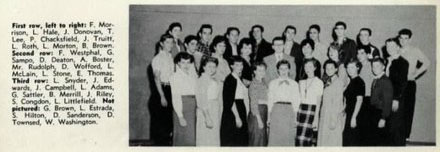
S. Congdon, L. Littlefield—Sophomores [p. 49]
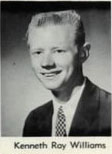
Kenneth Roy Williams—Senior [p. 36]
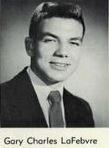
Gary Charles LaFebvre
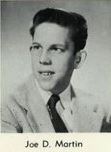
Joe D. Martin

Stewart Congdon—Junior [p. 48]

Larry Littlefield—Junior [p. 51]

Del Esquerra

J. Harris—Sophomore [p. 58]
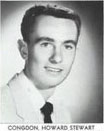
Congdon, Howard Stewart—Senior [p. 20]

Littlefield, Larry Wayde—Senior [p. 30]
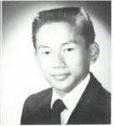
Delano Ramirez Esquerra

Harris, Jeff—Junior [p. 57]

Madeo, Elwood—Junior [p. 58]

Williams, Ronnie—Sophomore [p. 69]
The Ramblers—Shipwreck Dance, April 12, 1957
Special thanks to Javier Al Fresco

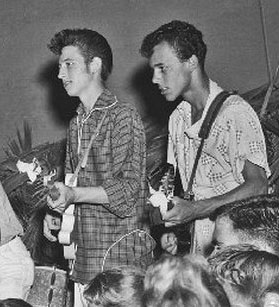
[Elwood Madeo on the right.]

Harris, Jeff Todd—Senior [p. 31]
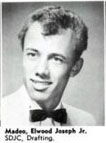
Madeo, Elwood Joseph Jr.—Senior [p. 37]

Williams, R.—Junior [p. 69]

Ralph Sherman Hensley

Ronald H. Williams—Senior [p. 55]
Additional informants: Tan Mitsugu, Javier Marcote (special thanks to Javier for finding and providing so much material)



























